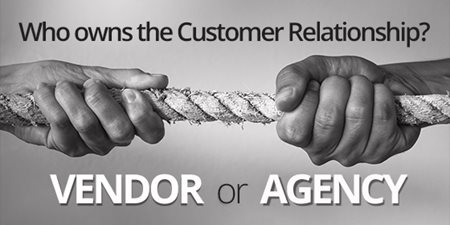Who Owns the Customer Relationship?
The sun is shining, and there is just a fresh, light breeze. Your drive is relaxed and effortless — there’s no traffic on your commute to the office. You arrive at work to a delicious aroma of baked goods; someone has brought in fresh, homemade muffins! Settling in, you open the first and only email that you’ve received this fine morning. It’s a status update on your website redesign project, and there are no issues. The development is ahead of schedule, third-party integrations are working seamlessly with the vendor CMS, and your agency is reporting out a lower than estimated cost.
[Cue record scratch]
You’re cruelly yanked out of your lovely daydream and plunked back down into your tormented reality. Your partner agency is asking for more money to implement solutions you clearly outlined in your scope of work, and your vendor denies that they didn’t confirm a key eCommerce integration would work. Your soft launch date is in five days, you have a broken site, and fingers are pointing at everyone, in every direction.
The Dream Customer. The Dream Vendor. The Dream Agency.
I think we all can say that we have chased the ‘unicorn trifecta’ of smooth work projects between the customer, vendor, and agency. However, when it goes awry, and the customer relationship begins to crumble, who takes accountability?
So, we have to ask. Who actually owns the customer relationship, the vendor, or the agency?
Throughout my career, I have been in the fortunate —in some instances, unfortunate — position to be on all three sides of the vendor, agency, client relationship.
As a vendor, we are sourced and chosen to provide the customer with a solution that meets their business requirements, integrates with existing or new software, and develop new products and features. The vendor is there to ensure the product will deliver what the client needs —and even more so — scale with their growth.
As an agency, we are chosen to work with, or source-out, the proper vendor to bring the client’s project to life, keep the project on schedule, and budget with our vendors to the best of our abilities to deliver for our client.
As a client, we source-out and choose the vendors and the agencies who fully understand our brand and how we work, and can deliver on the project we have outlined based on their reputation, portfolio, and pitch.
So, where does the accountability lie on issues such as choosing partners you can trust, and respect the ownership of the customer relationship.
The Agency and Customer Relationship
Just like any relationship, the agency and client relationship has its ups and downs, and both parties need to contribute the time, effort, and communication mutually. However, this style of relationship has evolved from the ‘Mad Men’ days. There is an increased need and competition for many skills, as well as a lack of loyalty — two-thirds of brands work with three or more digital agencies simultaneously, or they bring all of their digital marketing work in-house rather than outsource it.
The study, Mad Men to Sad Men, revealed the frustrations that customers and agencies have experienced in this fast-paced, fiercely competitive and crowded landscape, especially given the explosion in the number of specialists, tools, and technologies.
Agencies feelings included:
- Feeling less valued
- Struggling to deliver better, faster, cheaper
- Drifting downstream together — getting deep in the tactical weeds, away from business goals
- Collaborative competitiveness — too many cooks
- Not getting rewarded fairly
Clients feelings included:
- Agencies seen as selling, not listening
- Not understanding their world
- Not understanding the new world — failing to keep up
- Not understanding their customers
- No longer delivering the talent needed
- Not collaborating effectively
Clearly, we have valid frustrations on both sides, which can lead to the break-up of the relationship. As it happens, the industry average for the length of a client-agency relationship is 3.2 years. Some might argue that the average is shorter.
The Agency and Vendor Relationship
Truth be told, the same frustrations outlined above exist for the agency and vendor relationship. Most agencies partner with vendors to expand their overall service delivery by gaining specialized services they do not have, or the software required to meet customer needs.
Just the same, whether it’s between the agency, the customer, and the vendor, a healthy and robust relationship can be built. The key point to remember is that every relationship is a two-way street. Both parties play an equal role in engagement.
Some top tips to make these relationships work include:
- Don’t lose sight of what is important.
- Take the time and ask the right questions to get to know you and your businesses.
- Set clear goals about what success in the engagement looks like.
- Be brutally honest about expectations, communication needs, timelines, response times, and deliverables.
- Work strategically and respectfully with budgets and be transparent and proactive when projects or work will be out of scope.
- Carefully review and select the right team members and skills to deliver top quality work.
- Own up to your mistakes when they happen — you can learn from them.
- Show and practice flexibility.
- Be proactive and responsive.
- Commit fully to the process and the project.
- Be available and preach collaboration.
- Be honest with feedback and open to change.
- Be open and receptive to new ideas, out-of-the-box thinking.
- Push yourself out of your comfort zone, trying new techniques and exploring new ideas in your marketing.
- Serve as an equal partner.
- Invest in trust.
- Be accountable.
I genuinely believe that we all approach our relationships with the best of intentions. With that being said, when projects still go awry, who is responsible?
Recently, I was at an industry event with many sales and creative people in the room. I met with one such sales consultant who has over thirty years in the business, trains sales teams for large Fortune 500 companies, and helps develop processes for clients. Selfishly, I felt he would be a great person to pick his brain about this exact question.
I brought up the Hertz website redesign lawsuit. If you haven’t heard, Hertz is suing Accenture for $32million over a website redesign from hell. In 2016, the car-rental giant hired the consultancy firm to overhaul its corporate website completely. Hertz found itself immersed in a nightmare; a product and design that, allegedly, didn't do half of what was specified and still wasn't finished. The contract was terminated, and legal action ensued.
Accenture, however, was happy to resolve the issues, because it was all fixable. For a fee, of course. Despite missing the agreed-upon deadline by five months, with no completed elements, and a site weighed down by buggy code, Accenture told Hertz it would cost an additional $10m — this is on top of the $32m Accenture had already been paid — to finish the project. Now, imagine yourself as the vendor and agency who recommended them? Who owns the customer relationship with Accenture? Who needs to take accountability for this massive failure? My sales-friend said, first and foremost, it goes back to the sales process and what was promised. I too, as a PM, somewhat agreed that it should go right back to the scope of work. In the end, we both came to the consensus that it is the vendor and partner agencies’ responsibility to own the customer relationship.
We enter into a project as a team and need to build the customer relationship together as a team.

Lynette Sawyer
Lynette Sawyer is a Web Project Manager for Falcon-Software, a digital web agency founded in 1994. For the last 13-years Lynette has been in various digital capacities and her expertise goes beyond Project Management. Lynette brings experience and knowledge in graphic design, marketing communications, project management, product management and engagement.